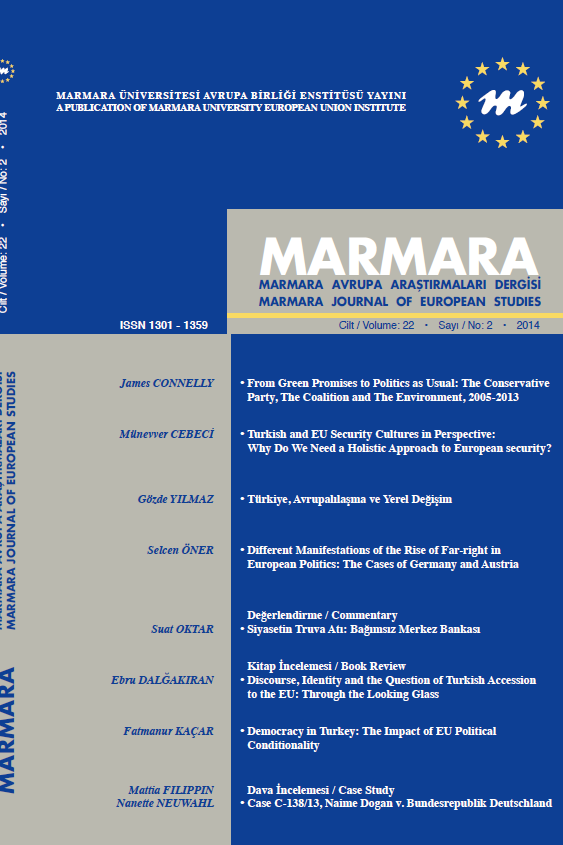PORTEKİZ İNŞAAT SEKTÖRÜNDE İFLAS BEKLENTİSİ
Bu çalışma, 150 iflas etmiş ve 150 halihazırda faaliyet gösteren şirketi inceleyerek, inşaat sektöründe bulunan Portekizli şirketlerin iflas olasılığı tahmininde belirleyici olduğu düşünülen, firmalara özgü değişkenleri belirlemeye çalışmaktadır. Makalede, iflas tahmini analiz etmek ve Logit ve Probit modellerinin yanı sıra doğrusal olasılık modeli uygulamak için, bir dizi ekonomik ve finansal oran kullanılmaktadır. Sonuçlar, iflas tahmini için en önemli oranın, nakit akışının toplam aktiflere oranı arttıkça iflas olasılığının düştüğünü belirten, nakit akışının toplam aktiflere oranı olduğunu göstermektedir. İnşaat krizinin ekonomiye yayılma etkisini en aza indirmek için sonuçlar politika yapıcılar tarafından kullanılabilir.
Anahtar Kelimeler:
İflas, iflas tahmini, finansal oranlar
INSOLVENCY PREDICTION IN THE PORTUGUESE CONSTRUCTION INDUSTRY
This study tries to determine the firms’ specific variables considered determinant to predict the probability of insolvency of Portuguese companies in the construction industry, considering a sample of 150 insolvent firms and 150 operating companies. We consider a set of economic and financial ratios to analyze the insolvency prediction and apply the linear probability model, as well as the Logit and Probit models. The results show that the main ratio to predict the insolvency was the cash-flow to total assets ratio, suggesting that the higher the cash-flow to total assets ratio value, the lower the probability of insolvency. The results can be used by policy makers to minimize the spill over effect of construction crisis to the economy.
Keywords:
Bankruptcy, insolvency prediction, financial ratios,
___
- Agarwal, V., & Taffler, R., (2008), “Comparing the performance of market-based and accounting-based bankruptcy prediction models”, Journal of Banking & Finance, 32, pp. 1541-1551.
- Altman, E., (1968), “Financial Ratios, Discriminant Analysis and the Prediction of Corporate Bankruptcy”, The Journal of Finance, 23 (4), pp. 589-609.
- Altman, E., Haldeman, R., & Narayanan, P., (1977), “Zeta analysis: A new model to identify bankruptcy risk of corporations”, Journal of Banking and Finance, 1, pp. 29-54.
- Barros, G., (2008), “Modelos de previsão da falência de Empresas: Aplicação Empírica ao Caso das Pequenas e Médias Empresas Portuguesas”, Master Dissertation, ISCTE, Instituto Universitário de Lisboa.
- Beaver, W., (1966), “Financial Ratios as Predictors of Failure”, Empirical Research in Accounting, selected studies, in supplement to the Journal of Accounting Research, pp. 71Blum, M. (1974), “Failing Company iscriminant Analysis”, Journal of Accounting Research, Spring, pp. 1-25.
- COFACE - Serviços Portugal (2012), Estudo anual de insolvências, créditos vencidos e constituições de empresas Portugal 2011.
- Correa, A., Acosta, M., & González, A. L., (2003), “La insolvencia empresarial: un análisis empírico para la pequeña y mediana empresa”, Spanish Accounting Review, 6 (12), pp. 47Edmister, R. (1972), “An Empirical Test of Financial Ratio Analysis for Small Business Failure Prediction”, The Journal of Financial and Quantitative Analysis, 7 (2), pp. 147714
- Frydman, H., Altman, E., & Kao, D., (1985), “Introducing Recursive Partitioning for Financial Classification: The Case of Financial Distress”, The Journal of Finance, 40 (1), pp. 269-291.
- Lacerda, A., & Moro, A., (2008), Analysis of the predictors of default for Portuguese firms. Working Paper 22, Banco de Portugal, Retrieved: 15 March 2013, http://www.diwecon.de/de/downloads/Moro%20BdP_2008-22.pdf.
- Laitinen, T., & Kankaanpää, M., (1999), “Comparative analysis of failure prediction methods: the Finnish case”, The European Accounting Review, 8 (1), pp. 67–92.
- Leal, C., & Machado-Santos, C., (2007), “Insolvency prediction in the Portuguese textile industry”, European Journal of Finance and Banking Research, 1 (1), pp. 16-28.
- McFadden, D., (1974), Condicional Logit Analysis of Qualitative Choice Analysis. New York: Academic Press.
- Ohlson, J., (1980), “Financial Ratios and the Probabilistic Prediction of Bankruptcy”, Journal of Accounting Research, 18 (1), pp. 109-131.
- Ribeiro, S., (2011), “Modelos de Previsão de Incumprimento Fiscal Através de Informação Financeira: Estudo das Empresas de Mobiliário de Madeira” Master Dissertation, Faculdade de Economia da Universidade do Porto.
- Ugurlu, M., & Aksoy, H., (2006), “Predicting Corporate financial distress in an emerging market: the case of Turkey”, Cross Cultural Management: An International Journal, 13 (4), pp. 277-295.
- Voulgaris, F., Doumpos, M., & Zopounidis, C., (2000), “On the Evaluation of Greek Industrial SMEs’: Performance via Multicriteria Analysis of Financial Ratios”, Small Business Economics, 15, pp. 127-136.
- Wooldridge, J., (2009) Introductory Econometrics. South-Western: Cengage Learning.
- Zavgren, C., (1985), “Assessing the vulnerability to failure of American Industrial Firms: A Logistic Analysis”, Journal of Business & Accounting, 12 (1), pp. 19-45.
- Zmijewski, M., (1984), “Methodological Issues Related to the Estimation of Financial Distress Prediction Models”, Journal of Accounting Research, 22 Supplement, pp. 59-82.
- ISSN: 1301-1359
- Yayın Aralığı: Yılda 2 Sayı
- Yayıncı: Marmara Üniversitesi
Sayıdaki Diğer Makaleler
ABD VE AB’NİN YENİ EKONOMİK İŞBİRLİĞİ STRATEJİLERİ VE TÜRKİYE’YE ETKİLERİ
Onur SUNGUR, Hidayet KESKİN, Murat DULUPÇU
THE EVOLUTION OF EU’S NEIGHBOURHOOD POLICY TOWARDS EASTERN EUROPE
PORTEKİZ İNŞAAT SEKTÖRÜNDE İFLAS BEKLENTİSİ
Elisabete S. VİEİRA, Carlos PİNHO, Carla CORREİA
TÜRKİYE’DE VE AVRUPA BİRLİĞİ’NDE TARIMSAL DESTEKLERİN GELİŞİMİ VE SEVİYESİ
AVRUPA BİRLİĞİ ADALET DİVANI’NIN AVRUPA BİRLİĞİ VATANDAŞLIĞI İLE İLGİLİ SON YAKLAŞIMLARI
AVRUPA KOMİSYONU’NUN MEŞRUİYETİ VE SİYASİ SORUMLULUĞU
